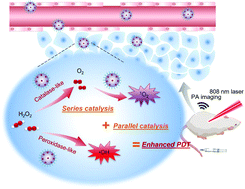A dual enzyme-mimicking radical generator for enhanced photodynamic therapy via series–parallel catalysis†
Abstract
Tumor hypoxia hampers the therapeutic efficacy of photodynamic therapy (PDT) by hardly supplying sufficient oxygen to produce cytotoxic compounds. Herein a dual enzyme-mimicking radical generator has been developed for the in situ generation of oxygen and abundant radical oxygen species to enhance PDT efficacy under photoacoustic imaging guidance. A manganese-incorporating and photosensitizer-loaded metal organic framework exhibited both catalase-like and peroxidase-like catalytic activities specifically at the tumor microenvironment, leading to simultaneous series catalysis and parallel catalysis pathways. As a result, the MOF-based radical generator nanoparticles can not only supply oxygen for PDT to produce singlet oxygen, but also generate hydroxyl radicals, thus further enhancing the anti-cancer effect of PDT. In vitro and in vivo evaluation of the radical generator nanoparticles demonstrated the relieved tumor hypoxia microenvironment, remarkably increased level of reactive oxygen species, and significantly improved anti-cancer effect with desirable PA imaging capacity. This work presents a “series–parallel catalysis” strategy enabled by a MOF nanozyme to enhance PDT efficiency and provides new insights into a highly efficient and low-toxic anti-cancer approach.

- This article is part of the themed collections: Celebrating International Women’s Day: Women in Nanoscience and Nanoscale 2022 Emerging Investigators


 Please wait while we load your content...
Please wait while we load your content...